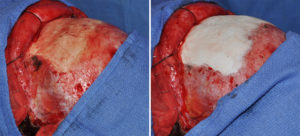Background: The shape of the forehead is very gender specific. Men have foreheads with distinct brow bone prominences, a visible brow bone break and a forehead that slopes somewhat less than vertical above it. Conversely females have no distinct brow bone, have a rounded or more convex forehead shape that ideally has a near vertical inclination.
The request for forehead augmentation is females is usually to provide increased convexity and verticality. The female forehead that is flatter and more recessed requires augmentation usually from above the brow bones up to or just past the edge of the frontal hairline. The shape of the augmentation is more important than its thickness or size.
The choice of augmentation material for the female forehead depends on how much surgical exposure is needed and what type of scalp incision the patient can tolerate. The smallest scalp incision with the least exposure needed is the custom forehead implant. For the use of hydroxyapatite cement a longer scalp incision is needed for greater exposure to properly apply the material and shape it as it sets.


Hydroxyapatite cement is a wonderful skull augmentation material, particularly in the forehead. It heals to the bone without a fibrous interface and can even have some bone growth into its microporous structure when set. Despite this major biologic advantage, it requires wide open access to properly apply the material. This means a coronal or pretrichial incision is needed to get an even application of the material that sets properly.
Highlights:
1) Forehead augmentation can be done by a variety of biomaterials, all of which can produce similar satisfactory results.
2) Hydroxyapatite cement is the most biologically favorable of all forehead augmentation materials.
3) The handling characteristics of hydroxyapatite cement requires wide open exposure for an aesthetically pleasing forehead contour.
Dr. Barry Eppley
Indianapolis, Indiana


